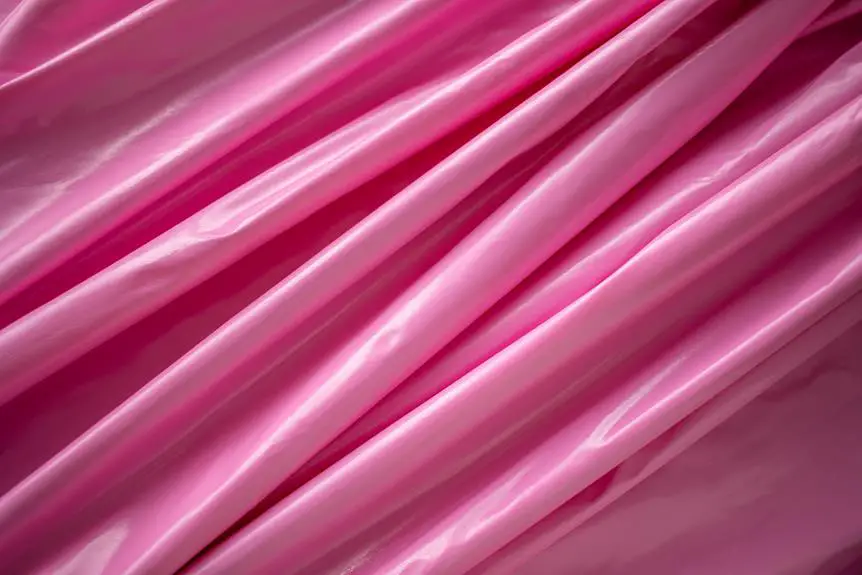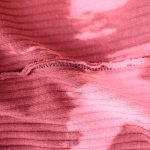Are you curious about whether Rit dye holds fast on various fabrics like a steadfast ally? Understanding the permanence of Rit dye on different fabrics is crucial for achieving vibrant and long-lasting results.
This article delves into the permanence of Rit dye on cotton, polyester, silk, and wool, as well as the factors that can impact its longevity.
By exploring the intricacies of Rit dye permanence, you'll gain mastery over the art of fabric dyeing and learn how to enhance the durability of your colorful creations.
Key Takeaways
- Rit dye has excellent permanence on cotton due to its deep penetration and bonding with the fibers.
- Achieving color fastness on polyester requires special attention and high heat application.
- Thorough preparation, dye application, heat setting, and color fastness testing are essential when dyeing silk with Rit dye.
- Proper fabric preparation, including pre-washing and using fixatives, enhances the permanence of Rit dye on different fabrics.
Understanding Rit Dye Permanence
To ensure the permanence of Rit dye on different fabrics, understanding the dye's properties is essential. Rit dye's permanence is influenced by its chemistry, particularly how it bonds with different fabrics. Understanding dye chemistry is crucial in achieving long-lasting color. Colorfastness testing is also imperative in assessing the dye's permanence. This testing evaluates how well the dye resists fading when exposed to various conditions such as light, washing, and friction.
Precautions for fading prevention are essential to maintain the permanence of Rit dye. Proper dye application techniques, including thorough fabric preparation and following Rit's specific dyeing instructions, contribute to the longevity of the color. Avoiding excessive heat and sunlight exposure after dyeing can also help prevent fading.
Rit Dye Permanence on Cotton
Rit dye's permanence on cotton depends on its ability to bond with the fabric's fibers, ensuring long-lasting color that resists fading through various conditions.
When dyeing cotton with Rit dye, you can expect:
- Dye Fastness: Rit dye penetrates the cotton fibers deeply, resulting in excellent dye fastness. This means the color is less likely to bleed or fade during washing, providing a vibrant and long-lasting finish.
- Fabric Types: Rit dye is specially formulated to work well with natural fibers like cotton. Its compatibility with the fabric ensures a strong bond, leading to superior color retention and dye longevity.
- Color Retention: Rit dye's chemical composition allows it to effectively bond with cotton, leading to exceptional color retention. This means the dyed cotton fabric will maintain its vividness over time, even with regular wear and laundering.
- Dye Longevity: When properly applied and set, Rit dye creates enduring color on cotton. The dye's lasting power ensures that your dyed cotton items will remain vibrant and appealing for an extended period.
Rit Dye Permanence on Polyester
When dyeing polyester with Rit dye, you will notice that the color penetration and permanence differ from that of cotton due to the fabric's synthetic composition. Polyester dyeing techniques require special attention to achieve long-lasting color results. Rit dye, specifically formulated for synthetic fibers, can bond with polyester through high heat application, such as using a stovetop method or a washing machine dyeing technique. However, it's essential to note that achieving color fastness on polyester can be more challenging compared to natural fibers like cotton. Color fastness testing is crucial to ensure the permanence of the dye on polyester fabric. Here's a comparison table to illustrate the differences in dye permanence between cotton and polyester:
| Aspect | Cotton | Polyester |
|---|---|---|
| Color Penetration | Deep penetration | Limited penetration |
| Permanence | Easier to achieve | More challenging |
| Heat Application | Lower heat requirement | Higher heat requirement |
| Color Fastness Test | Typically more reliable | Requires meticulous testing |
Understanding these differences will help you adjust your dyeing techniques and expectations when working with polyester fabrics.
Rit Dye Permanence on Silk
Achieve lasting color results on silk with Rit dye by ensuring proper heat application and meticulous color fastness testing.
When dyeing silk with Rit dye, it's essential to follow specific techniques to ensure the permanence of the color. Here's how to achieve permanent results:
- Preparation: Begin by thoroughly washing the silk fabric to remove any dirt, oils, or finishes that could prevent the dye from properly adhering to the fibers.
- Dye Application: Mix the Rit dye according to the package instructions and apply it to the silk fabric using the desired dyeing technique, such as immersion dyeing or tie-dyeing, ensuring even coverage and saturation.
- Heat Setting: After dyeing, carefully heat set the color by either steaming or using an iron to ensure the dye molecules bond with the silk fibers, creating a permanent bond.
- Color Fastness Testing: Before using or washing the dyed silk, perform color fastness testing by rubbing a damp white cloth over the dyed area to ensure minimal color transfer.
Rit Dye Permanence on Wool
To ensure lasting color results on wool with Rit dye, follow specific dyeing techniques and conduct thorough color fastness testing.
Wool, being a protein fiber, requires careful attention during the dyeing process. Before dyeing, it's crucial to thoroughly clean the wool to remove any natural oils or dirt that could hinder the dye absorption.
Preparing the dye bath according to the Rit dye instructions is essential. Use hot water and stir continuously to ensure even distribution of the dye.
When dyeing wool, it's important to monitor the temperature of the dye bath, as extreme heat can cause the wool to shrink or felt. Additionally, controlling the acidity of the dye bath is crucial for achieving the desired color results on wool.
After dyeing, rinse the wool thoroughly in lukewarm water and gently squeeze out the excess water. Avoid wringing or twisting the wool to prevent damage to the fibers.
Following these fabric dyeing techniques will help ensure that Rit dye produces permanent and vibrant colors on wool.
Factors Affecting Rit Dye Permanence
When it comes to the permanence of Rit dye on different fabrics, several factors come into play.
The type of fabric you're dyeing can significantly impact the dye's permanence, as different materials absorb and hold color differently.
Additionally, the temperature and duration of the dyeing process, as well as the necessity of pre-treating the fabric, are crucial factors to consider for achieving long-lasting and vibrant results.
Fabric Type Impact
You may notice that the type of fabric you choose significantly impacts the permanence of Rit dye. Factors affecting the permanence of Rit dye on different fabrics include:
- Fabric Durability: More durable fabrics like cotton, linen, and silk tend to hold Rit dye better than delicate fabrics such as rayon or modal due to their ability to withstand the dyeing process without significant damage.
- Dye Penetration: Fabrics with a looser weave or porous texture, such as cotton or rayon, allow the dye to penetrate more effectively, resulting in a more permanent color compared to tightly woven fabrics like polyester or nylon.
- Fabric Composition: Natural fabrics like cotton and silk tend to hold Rit dye more permanently than synthetic fabrics, as the dye molecules bond more effectively with natural fibers.
- Fabric Finish: The finish of the fabric, such as being pre-treated with chemicals for wrinkle resistance or water repellency, can impact the ability of Rit dye to permanently adhere to the fabric.
Temperature and Duration
How does the temperature and duration of the dyeing process affect the permanence of Rit dye on different fabrics?
Temperature accuracy is crucial when using Rit dye. It's essential to maintain the water temperature within the specified range for the type of fabric being dyed, as this affects the dye's ability to bond with the fibers. Using a thermometer to ensure the water is at the correct temperature is highly recommended.
Additionally, dyeing duration efficiency is key to achieving permanent color. The duration of time the fabric is in the dye bath directly impacts how well the color adheres to the fibers. Following the dyeing instructions meticulously, including the recommended duration for each fabric type, is vital in ensuring the permanence of Rit dye on different fabrics.
Pre-Treatment Necessity
To ensure the permanence of Rit dye on different fabrics, it's essential to consider the necessity of pre-treatment, as it directly impacts the dye's ability to bond with the fibers.
Pre-treatment benefits:
Pre-treating fabrics with a fixative or mordant can enhance the dye's ability to bond with the fibers, resulting in a more permanent coloration.
Fabric compatibility:
Different fabrics require different pre-treatment methods. For example, natural fibers like cotton and wool may require a different pre-treatment approach compared to synthetic fabrics like polyester or nylon.
pH balance:
Adjusting the pH level of the fabric through pre-treatment can significantly impact the dye's ability to penetrate and bond with the fibers.
Stain removal:
Pre-treatment involving thorough stain removal ensures that the dye can uniformly color the fabric, leading to a more permanent and even result.
Tips for Enhancing Rit Dye Permanence
To enhance the permanence of Rit dye on different fabrics, consider using a color fixative to help set the dye and prevent it from fading.
Additionally, proper fabric preparation, such as pre-washing the fabric to remove any finishes or sizing, can help the dye adhere more effectively.
These tips can contribute to a more permanent and vibrant result when using Rit dye on various types of fabric.
Color Fixative Options
To enhance the permanence of Rit dye on different fabrics, consider using a color fixative option. Here are some tips for enhancing Rit dye permanence:
- Vinegar: Add vinegar to the dye bath to help set the color and make it more permanent.
- Salt: When dyeing cotton or linen fabrics, using salt can help the dye adhere better and improve colorfastness.
- Commercial Fixatives: Consider using a commercial color fixative specially formulated for fabric dyeing to enhance color permanence.
- Heat Setting: After dyeing, use a hot iron or a clothes dryer to heat set the color, making it more resistant to fading.
Proper Fabric Preparation
For enhancing the permanence of Rit dye on different fabrics, your fabric's preparation is crucial. Proper fabric preparation ensures that the dye adheres to the fabric effectively, resulting in a longer-lasting color.
Before dyeing, it's essential to wash the fabric to remove any dirt, finishes, or sizing that could hinder dye absorption. Pre-washing also helps to remove any invisible stains or oils that can repel the dye.
Additionally, consider using a dye fixative or mordant to help the color bind to the fabric fibers. When applying the dye, ensure that the fabric is thoroughly wet to promote even dye penetration.
Follow dye application techniques carefully, such as immersion dyeing, dip dyeing, or tye-dye methods, to achieve the desired color results.
Proper fabric preparation and dye application techniques are fundamental in enhancing Rit dye permanence.
Testing Rit Dye Permanence on Different Fabrics
Have you tested Rit Dye's permanence on various fabrics? When testing Rit Dye's permanence, there are crucial factors to consider. Here are four essential aspects to evaluate the permanence of Rit Dye on different fabrics:
- Testing Methods: Utilize various testing methods such as colorfastness tests, wash tests, and lightfastness tests to assess the permanence of Rit Dye on different fabrics. This will provide a comprehensive understanding of how the dye adheres to specific materials.
- Dye Penetration: Evaluate the dye penetration into the fabric fibers. This can be done by examining cross-sections of the dyed fabric under a microscope to assess how deeply the dye has penetrated the fibers and whether it has bonded effectively.
- Color Fastness: Assess the color fastness of Rit Dye on different fabrics by subjecting the dyed materials to different environmental conditions such as washing, exposure to light, and friction to determine color retention and resistance to fading.
- Fabric Compatibility: Test Rit Dye on a variety of fabrics to determine its compatibility with different materials, including natural and synthetic fibers, to understand how the dye interacts with each fabric type.
Frequently Asked Questions
Can Rit Dye Be Used to Dye Outdoor Fabrics Like Polyester or Nylon for Long-Lasting Color?
Yes, Rit dye can be used to dye outdoor fabrics like polyester or nylon for long-lasting color. The dye provides outdoor durability and helps maintain colorfastness, ensuring the fabric retains its vibrant color over time.
Will Rit Dye Work on Blended Fabrics, Such as Cotton/Polyester or Wool/Silk Blends?
Yes, Rit dye can be used on cotton/polyester blends and wool/silk blends. It provides colorfastness and requires washing maintenance to retain the vibrancy. Following proper dyeing and care instructions will ensure long-lasting color on these fabrics.
How Does Rit Dye Hold up on Heavily Used Items, Like Clothing or Upholstery?
Rit dye color retention and fabric durability in use are impressive. The long term colorfastness and maintaining vibrancy in use make it ideal for heavily used items like clothing or upholstery. It's great for fabric color maintenance.
Can Rit Dye Be Used to Touch up or Re-Dye Faded or Worn Fabrics?
To touch up dyeing and restore faded or worn fabrics, Rit dye can be used. Ensure colorfastness and follow maintenance tips for long-lasting results. It's an effective way to breathe new life into your textiles.
Are There Any Special Considerations for Maintaining the Colorfastness of Rit Dyed Fabrics During Washing or Dry Cleaning?
To maintain colorfastness when using Rit dye, follow care instructions for washing and dry cleaning. Consider using Rit's long-lasting outdoor dye for heavily used items. For blended fabrics, ensure durability by touching up or re-dyeing as needed.
- What Ink Is Best for Printing on PP Woven and Nonwoven Bags? - July 11, 2025
- How to Draft a Glove Pattern for Nonwoven Fabrics - July 11, 2025
- How to Use Sterile Nonwoven Sponges for Medical Applications - July 11, 2025







